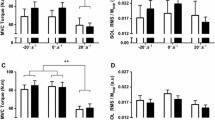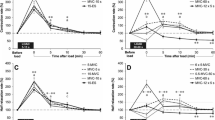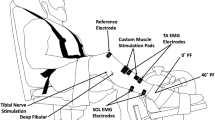Abstract
Purpose
The study investigated potential mechanisms underlying the beneficial effects of performing serial contractions for increasing muscle performance.
Methods
Thirteen men performed maximal isometric dorsiflexion contractions to a limited amount of fatigue. The recovery pattern was monitored over 15 min. Force, surface electromyography (sEMG) of the agonist and antagonist, and skin temperature were observed. Evoked potentials were elicited.
Results
Force decreased to 206 ± 40 N and recovered to 243 ± 55 N (102 % of initial value). While full recovery is noteworthy, it was not significant (p = 0.24). Surface EMG root-mean-square (RMS) amplitude did not fully recover: tibialis anterior (219 ± 46 versus 242 ± 63 μV, 91 %) and soleus (13 ± 5 versus 16 ± 6 μV, 82 %). The result was an 11 % decrease in the co-activation ratio during recovery. Tibialis anterior and soleus mean power frequency (MPF) “over-recovered” to 117 % (144 ± 25 versus 124 ± 27 Hz) and 118 % (80 ± 14 versus 68 ± 11 Hz) of initial value, respectively. Peak rate of force development (RFD) during recovery was 146 % of initial (743 ± 246 versus 509 ± 271 N). Skin temperature increased 0.6 °C over the test session. Potentiation was not present during recovery, as assessed by twitch force.
Conclusions
The return of force to initial values, rather than a persistent decrement was a result of several mechanisms operating simultaneously. The sEMG data indicate an increase in conduction velocity, while an increase in peak RFD suggests contraction-induced facilitation of ATPase pump activity. However, alterations in muscle coordination were observed as a reduction in antagonist co-activity.



Similar content being viewed by others
Abbreviations
- ANOVA:
-
Analysis of variance
- ATPase:
-
Adenosine triphosphatase
- EMG:
-
Electromyography
- MPF:
-
Mean power frequency
- MVC:
-
Maximal voluntary contraction
- Q30 :
-
The rate of increase in the sEMG signal from onset to 30 ms
- RFD:
-
Rate of force development
- RMS:
-
Root-mean-square
- sEMG:
-
Surface electromyography
References
Aagaard P, Simonsen E, Andersen J, Magnusson P, Dyhre-Poulsen P (2002) Increased rate of force development and neural drive of human skeletal muscle following resistance training. J Appl Physiol 93:1318–1326
Andersen LL, Aagaard P (2006) Influence of maximal muscle strength and intrinsic muscle contractile properties on contractile rate of force development. Eur J Appl Physiol 96(1):46–52
Baker A, Kostov K, Miller R, Weiner M (1993) Slow force recovery after long-duration exercise: metabolic and activation factors in muscle fatigue. J Appl Physiol 74(5):2294–2300
Baratta R, Solomonow M, Zhou B-H, Zhu M (1998) Methods to reduce the variability of EMG power spectrum estimates. J Electromyogr Kines 8:279–285
Behm D, St-Pierre D (1998) Fatigue mechanisms in trained and untrained plantar flexors. J Strength Cond Res 12(3):166–172
Calder K, Gabriel DA (2007) Adaptations during familiarization to resistive exercise. J Electromyogr Kines 17:328–335
Carolan B, Cafarelli E (1992) Adaptations in coactivation after isometric resistance training. J Appl Physiol 73(3):911–917
Christie A, Lester S, LaPierre D, Gabriel DA (2004) Reliability of a new measure of H-reflex excitability. Clin Neurophysiol 115(1):116–123
Enoka R, Stuart D (1992) Neurobiology of fatigue. J Appl Physiol 72(5):1631–1648
Erim Y, De Luca C, Mineo K, Aoki T (1996) Rank-ordered regulation of motor units. Muscle Nerve 19:563–573
Farina D, Merletti R (2000) Comparison of algorithms for estimation of EMG variables during voluntary isometric contractions. J Electromyogr Kines 10(5):337–349
Feiereisen P, Duchateau J, Hainaut K (1997) Motor unit recruitment order during voluntary and electrically induced contractions in the tibialis anterior. Exp Brain Res 114:117–123
Gabriel D, Basford J, An K (2001) Neural adaptations to fatigue: implications for muscle strength and training. Med Sci Sport Exer 33(8):1354–1360
Gottlieb GL, Corcos DM, Agarwal GC (1989) Organizing principles for single-joint movements I. A speed-insensitive strategy. J Neurophysiol 62(3):342–357
Hamada T, Sale G, MacDougall D, Tarnopolsky M (2000) Postactivation potentiation, fibre type, and twitch contraction time in human knee extensor muscles. J Appl Physiol 88:2131–2137
Hara T (1980) Evaluation of recovery from local muscle fatigue by voluntary test contractions. J Hum Ergol 9(1):35–46
Hebert LJ, De Serres SJ, Arsenault AB (1991) Cocontraction of the elbow muscles during combines tasks of pronation-flexion and supination-flexion. Electromyogr Clin Neurophysiol 31:483–488
Hedayatpour N, Arendt-Nielsen L, Farina D (2008) Non-uniform electromyographic activity during fatigue and recovery of the vastus medialis and lateralis muscles. J Electromyogr Kines 18:390–396
Hicks A, McComas AJ (1989) Increased sodium pump activity following repetitive stimulation of rat soleus muscles. J Physiol 414:337–349
Hodges PW, Bui BH (1996) A comparison of computer-based methods for the determination of onset of muscle contraction using electromyography. Electroenceph Clin Neurophysiol 101:511–519
Inglis JG, Vandenboom R, Gabriel DA (2013) Sex-related differences in maximal rate of isometric torque development. J Electromyogr Kines 23(6):1289–1294
Jakobi J, Rice C, Curtin S, Marsh G (2000) Contractile properties, fatigue and recovery are not influenced by short-term creatine supplementation in human muscle. Exp Physiol 85(4):451–460
Jay O, Gariepy LM, Reardon FD et al (2007) A three-compartment thermometry model for the improved estimation of changes in body heat content. Am J Physiol Regul Integr Comp Physiol 292:R167–R175
Kenny GP, Reardon FD, Zaleski W et al (2003) Muscle temperature transients before, during, and after exercise measured using an intramuscular multisensor probe. J Appl Physiol 94:2350–2357
Kooistra R, de Ruiter C, de Haan A (2005) Muscle activation and blood flow do not explain the muscle length-dependent variation in quadriceps isometric endurance. J Appl Physiol 98:810–816
Kroll W (1967) Recovery patterns after local muscular fatigue for different levels of isometric strength. Int Z Angew Physiol 23(4):331–339
Kroll W (1971) Recovery patterns after local muscular fatigue for different levels of isometric strength in college age females. Am Correct Ther J 25(5):132–138
Kuorinka I (1988) Restitution of EMG spectrum after muscular fatigue. Eur J Appl Physiol 57:311–315
Marsh E, Sale D, McComas J, Quinlan J (1981) Influence of joint position on ankle dorsiflexion in humans. J Appl Physiol 51(1):160–167
McIntosh K, Gabriel DA (2012) Reliability of a simple method for determining muscle fibre conduction velocity. Muscle Nerve 45:257–265
McNeil C, Doherty T, Stashuk D, Rice C (2005) Motor unit number estimates in the tibialis anterior muscle of young, old, and very old men. Muscle Nerve 31:461–467
Metzger J, Greaser M, Moss R (1989) Variations in cross-bridge attachment rate and tension with phosphorylation of myosin in mammalian skinned skeletal muscle fibers. J Gen Physiol 93:855–883
Mills K (1982) Power spectral analysis of electromyogram and compound muscle action potential during muscle fatigue and recovery. J Physiol 326:401–409
Nielsen OB, Clausen T (2000) The Na+/K+-pump protects muscle excitability and contractility during exercise. Exerc Sport Sci Rev 28(4):159–164
Persechini A, Stull J, Cooke R (1985) The effect of myosin phosphorylation on the contractile properties of skinned rabbit skeletal muscle fibres. J Biol Chem 260(13):7951–7954
Reimers CD, Harder T, Saxe H (1998) Age-related muscle atrophy does not affect all muscles and can partly be compensated by physical activity: an ultrasound study. J Neurol Sci 159:60–66
Rutkove S (2001) Effects of temperature on neuromuscular electrophysiology. Muscle Nerve 24:867–882
Sale D (2004) Postactivation potentiation: role in performance. Brit J Sport Med 38:386–387
Stewart D, Macaluso A, De Vito G (2003) The effect of an active warm-up on surface EMG and muscle performance in healthy humans. Eur J Appl Physiol 89:509–513
Stokes M, Dalton P (1991) Acoustic myography for investigating human skeletal muscle fatigue. J Appl Physiol 71(4):1422–1426
Stull GA, Clarke D (1971) Patterns of recovery following isometric and isotonic strength decrement. Med Sci Sports 3(3):135–139
Sweeney H, Stull J (1990) Alteration of cross-bridge kinetics by myosin light chain phosphorylation in rabbit skeletal muscle: implications for regulation of actin-myosin interaction. Proc Nat Acad Sci USA 87:414–418
Thornley LJ, Maxwell NS, Cheung SS (2003) Local tissue temperature effects on peak torque and muscular endurance during isometric knee extension. Eur J Appl Physiol 90:588–594
Tillin NA, Pain MTG, Folland JP (2011) Short-term unilateral resistance training affects the agonist–antagonist but not the force–agonist activation relationship. Muscle Nerve 43(3):375–384
Van der Hoeven J, Lange F (1994) Supernormal muscle fibre conduction velocity during intermittent isometric exercise in human muscle. J Appl Physiol 77(2):802–806
Van der Hoeven J, Van Weerden T, Zwarts M (1993) Long-lasting supernormal conduction velocity after sustained maximal isometric contraction in human muscle. Muscle Nerve 16:312–320
Vandenboom R, Grange RW, Houston ME (1993) Threshold for force potentiation associated with skeletal myosin phosphorylation. Am J Physiol-Cell Ph 265(6):C1456–C1462
Vandenboom R, Grange RW, Houston ME (1995) Myosin phosphorylation enhances rate of force development in fast-twitch skeletal muscle. Am J Physiol-Cell Ph 268(3):C596–C603
Winkel J, Jorgensen K (1991) Significance of skin temperature changes in surface electromyography. Eur J Appl Physiol 63:345–348
Zwarts M, Van Weerden T, Haenen H (1987) Relationship between average muscle fibre conduction velocity and EMG power spectra during isometric contraction, recovery and applied ischemia. Eur J Appl Physiol 56:212–216
Acknowledgments
This work was funded by an operating Grant to the corresponding author from the Natural Sciences and Engineering Research Council of Canada.
Conflict of interest
There are no conflicts of interest associated with this work.
Author information
Authors and Affiliations
Corresponding author
Additional information
Communicated by Toshio Moritani.
Rights and permissions
About this article
Cite this article
Green, L.A., Parro, J.J. & Gabriel, D.A. Beneficial effects of serial contractions on muscle performance after a brief period of rest. Eur J Appl Physiol 114, 1657–1665 (2014). https://doi.org/10.1007/s00421-014-2896-8
Received:
Accepted:
Published:
Issue Date:
DOI: https://doi.org/10.1007/s00421-014-2896-8




